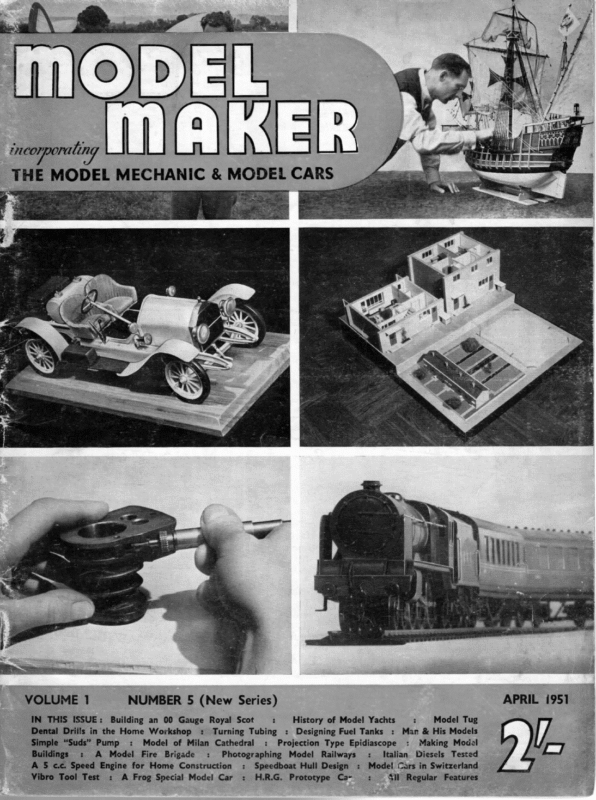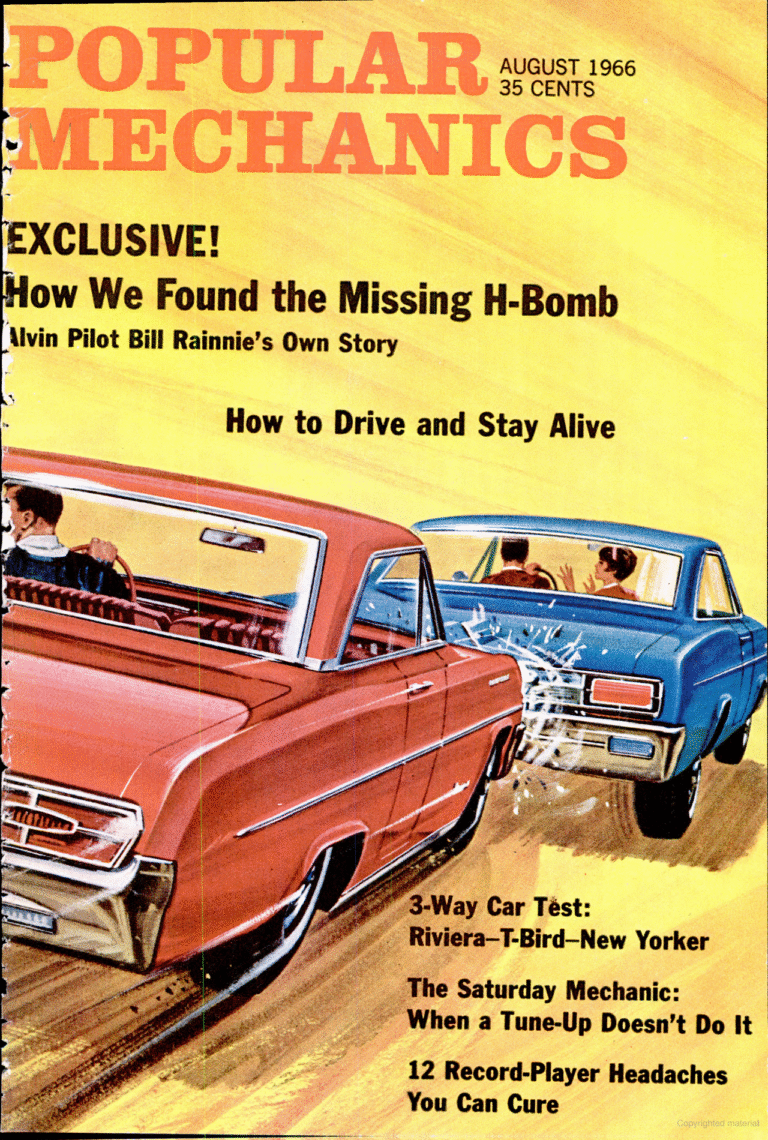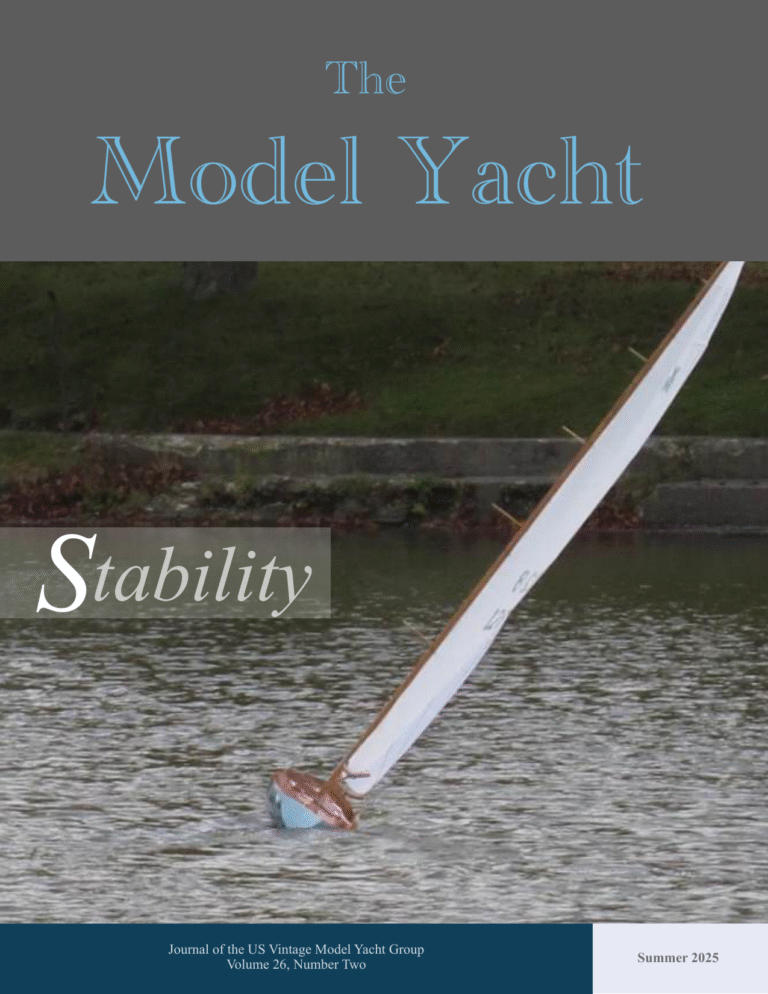KER ‘neorporaling Simple “Suds” Pump : A : Model Model of Milan Cathedral Fire Brigade : : Designing Fuel Tanks Model : Railways A 5 «.c. Speed Engine for Home Construction : Speedboat Hull Design : H.R.G. A Frog Special Model Car : Prototype Ca~ : Model Tug Man & His Models Projection Type Epidiascope Photographing Vibro Tool Test : : Italian Making Model Diesels Tested Mode! Cars in Switzerland : $i Regular Features . History of Model Yachts : ty : Turning Tubing and : 4 Building an 00 Gauge Royal Scot Dental Drii!s in the Home Workshop + IN THIS ISSUE: Buildings APRIL 1951 NUMBER 5 (New Series) Mail VOLUME 1 “aes ictal THE MODEL MECHANIC & MODEL CARS
jt MODEL | MAKER . History & Develop “History and Development of Model Yachts” is the first of a new series by Bernard Reeve, M.S.N.R., and provides interesting comparisons with the scientifically built models of today. His next article will deal with more modern types, describing each with notes on displace- OW old is the pastime of building model sailing boats? I very much doubt whether there is any individual who would be prepared to answer this question with any degree of chronological accuracy for the art is lost in the mists of time. ment, sail areas and rating rules. There will also be some instructions to the beginner on sailing with the Braine steering gear. A further article will cover the future of the sport, in- Proof of its antiquity has been confirmed by finds in the tombs of the Egyptian Pharaohs as far back as the XII Dynasty; some of the best examples coming from the tomb of Tutankhamen. It is doubtful whether these models were ever intended to be sailed; it is far more likely that they were the forerunners of the votive ship models one sees suspended from the roofs of many Continental churches. cluding observations on the possibilities of some extension in the use of radio control for model yachts. A design of the author’s embodying ideas for a new experimental class of model should provide additional interest. Models have also been found during excavations in the Near East whose age is authoritatively stated to be 10,000 years. Similarly, at Ur of the Chaldeans an exquisitely modelled nine-oared canoe of silver was found. Antiquarians dated this model at 3500 B.C. This is, of course, of purely academic interest, and is only included here to show that our hobby is one of the oldest in the world. In order to trace the development of the modern sailing model it is only necessary to go back to the beginning of the present century for this appears to be the date when actual sailing models came into prominence in any numbers on an organised basis. Fig. 1 illustrates a model of this period. Its design was based upon a smack or small coaster, and the science of naval architecture as applied to model yachts did not enter into the scheme of things. Usually the model was carved from a solid block of yellow pine until it pleased the eye. It was cutter rigged, the main mast fitted with a topmast and the main sail attached by means of mast hoops, as in the prototype. These boats must have been very difficult to sail on a straight course as there was no attempt to balance the sails to the hull, and of course, there was no such thing as automatic steering. The rudder was usually fitted with a tiller which engaged with a toothed rack on the deck. The next step was one in the right direction (Fig. 2) for here we see a model designed specially for racing. Many of my older readers will remember these craft with their metal fins to which was attached a bulb keel. They were sloop rigged and fitted with a single pole mast together with a boom and gaff, to which the sails were laced. Steering had advanced and now took the form of a brass pendulum rudder hooked to the after end of the back fin. This type of rudder is shown in Fig. 6 and con- sisted of plate, usually of 16 gauge brass. This plate was slotted and carried a screwed rod upon which a lead ball was threaded. This ball could be moved along the rod to any desired position, according to the course being sailed. The action of this, and other 270
April 1951 ent of Model Yachts types of swing rudders, is such that as the boat heels over when the wind hardens, the rudder swings over thus applying more helm, bringing the model back on her course. When running before the wind the weight was screwed right to the end. With the wind on the beam, i.e. reaching, the ball would be near the stern post end. When beating, ie. sailing into the wind, it was usually possible to dispense with the rudder altogether as under this condition the model would sail a true course provided the hull had no vices, such as twisted fins, or other defects in building. Designers now began to take a more active interest in the design of models for racing purposes, and to apply a modicum of science which for years past had been devoted only to full-sized yachts. In fact one began to see the influence of the yacht architect’s half models. Fig. 3 shows a further advance in design. Here we have a more modern type of canoe body with a full wooden keel. The model was still a gaff rigged sloop with sails laced to their respective booms and the rudder was still of the swing type, but of a different pattern, details of which are shown in Fig. 7. : It was usual at this time for the model yachtsman to carry about half a dozen of these rudders of varying weights to meet all conditions of weather and course. Another version of the swing-type rudder is shown in Fig. 5. This consisted of a nicely fitted stock and blade balanced on a pintle bearing. The lead weight was adjustable along the length of the tiller—which pointed aft—and its action was such that as the boat heeled the weight swung to the side heeled with varying pressure according to the position of the weight, thus putting the rudder a’weather and acting in the same way as the brass rudder previously described, but with more pressure. An event now took place which revolutionised the handling of model racing yachts. Just prior to the first World War Mr. G. Braine of the M.Y.S.A. invented the automatic steering gear bearing his name. Its success was immediate for models fitted with the old-fashioned swing rudders which were erratic or completely unmanageable under certain conditions of wind now behaved as well-bred yachts should. Although this gear is well known to all model yachtsmen there may be many newcomers to the sport not so familiar with it and for their benefit I have illustrated the gear in Fig. 8 which is a diagrammatic layout and not drawn to scale. This device consists of a metal quadrant (1) shaped as shown attached to the rudder head by means of a 6 B.A. screw. Immediately behind the tail of the quadrant is a metal slide (2) which travels the full length of the guide. The rubber cord (3) is anchored to the after 271
MODEL MAKER 3 LOCKING PLATE. end of the deck and is double. It passes through the slide, through a hole in the turned down end of the quadrant, passes on either side of the rudder head and is adjusted for tension by means of a cord and bowsie (4) A pair of pulleys (5) are screwed to the deck, using a link so that they can swing freely. These are for the steering lines (6). Looking at the main-boom (7) it will be observed that there is a jack line to which are attached two circular bowsies (8), one for the steering lines and the other for the beating sheet. ° The steering lines, which must be exactly equal in length, are connected to the inner bowsie, pass through a ring on the boom, through the pulleys and are attached to a pair of quadrant hooks which engage with one or other of the holes drilled in the fore end of the quadrant. Astride of the quadrant will be seen the main horse (10) and traveller (11) to which is attached the beating sheet (9). This is only used when sailing close-hauled, the Braine gear being slacked right out and not operative when sailing under these conditions. Y It is usual to calibrate the main boom as shown so that the correct setting of running lines and beating sheet can be repeated. Z It is of the utmost importance to see that the rudder is completely free in the trunk, not loose, for the rudder must be free to return to the central position as soon as pressure is released. The accepted method of. doing this is to drill a 7, in. clearance hole + in. into the lower end of the rudder stock and make a pointed bearing of + in. rod soldered to a sole plate screwed to the bottom of the skeg. Fig. 9 gives details of the Braine gear dimensioned for “M” Class and 36 in. R_= Class models. 272





